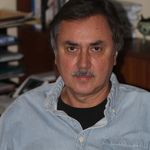Adipocytes, skeletal myocytes and some neurons express a specific isoform of the glucose transporter protein, Glut4. Under basal conditions this transporter is localized in intracellular membrane vesicles which fuse with the plasma membrane upon insulin administration. Translocation of Glut4 plays a major role in post-prandial glucose clearance and, more generally, in glucose sensing and metabolic homeostasis in the body. For a number of years, my lab has been involved in the dissection of the “Glut4 pathway” in various insulin-sensitive cells.
Another key physiological function of insulin is to inhibit lipolysis and to promote storage of triglycerides in fat tissue. Recently, we have discovered two novel pathways of regulation of lipolysis by insulin. One of these pathways is mediated by the insulin- and nutrient-sensitive mammalian Target of Rapamycin Complex 1, while the other is mediated by the transcription factor FoxO1. Currently, we are engaged in the dissection of both pathways at the molecular level.
Fat represents an important secretory tissue in the body. Unlike typical endocrine and exocrine cells, adipocytes produce and secret several physiologically important proteins, such as leptin, adiponectin, lipoprotein lipase, etc. and switch the secretory process from one protein to another in response to changing metabolic conditions. We are exploring connections between food intake, obesity and secretion of adipokines in order to understand the central role of fat tissue in the orchestrating the overall response of the organism to changing metabolic conditions.
[/collapsible]
Representative Publications
-
Zaarur N, Desevin K, Mackenzie J, Lord A, Grishok A, Kandror KV. ATGL-1 mediates the effect of dietary restriction and the insulin/IGF-1 signaling pathway on longevity in C. elegans. Mol Metab. 2019 09; 27:75-82. PMID: 31311719
-
Pan X, Meriin A, Huang G, Kandror KV. Insulin-responsive amino peptidase follows the Glut4 pathway but is dispensable for the formation and translocation of insulin-responsive vesicles. Mol Biol Cell. 2019 06 01; 30(12):1536-1543. PMID: 30943117
-
Mohtar O, Ozdemir C, Roy D, Shantaram D, Emili A, Kandror KV. Egr1 mediates the effect of insulin on leptin transcription in adipocytes. J Biol Chem. 2019 04 12; 294(15):5784-5789. PMID: 30846562
-
Zaarur N, Pan X, Kandror KV. Detection of Detergent-sensitive Interactions Between Membrane Proteins. J Vis Exp. 2018 03 07; (133). PMID: 29578521
-
Boesze-Battaglia K, Walker LP, Dhingra A, Kandror K, Tang HY, Shenker BJ. Internalization of the Active Subunit of the Aggregatibacter actinomycetemcomitans Cytolethal Distending Toxin Is Dependent upon Cellugyrin (Synaptogyrin 2), a Host Cell Non-Neuronal Paralog of the Synaptic Vesicle Protein, Synaptogyrin 1. Front Cell Infect Microbiol. 2017; 7:469. PMID: 29184850
-
Kandror KV. Mammalian target of rapamycin complex 1 and FoxO1 in the transcriptional control of lipolysis and de novo lipogenesis. Curr Opin Endocrinol Diabetes Obes. 2017 Oct; 24(5):326-331. PMID: 28841634
-
Pan X, Zaarur N, Singh M, Morin P, Kandror KV. Sortilin and retromer mediate retrograde transport of Glut4 in 3T3-L1 adipocytes. Mol Biol Cell. 2017 Jun 15; 28(12):1667-1675. PMID: 28450454
-
Kandror KV. The Role of Sortilin in the “Glut4 Pathway”. Communicative & integrative biology. 2017; 11(1). View Publication
-
Chakrabarti P, Kandror KV. The role of mTOR in lipid homeostasis and diabetes progression. Curr Opin Endocrinol Diabetes Obes. 2015 Oct; 22(5):340-6.View Related Profiles. PMID: 26241026
-
Singh M, Shin YK, Yang X, Zehr B, Chakrabarti P, Kandror KV. 4E-BPs Control Fat Storage by Regulating the Expression of Egr1 and ATGL. J Biol Chem. 2015 Jul 10; 290(28):17331-8.View Related Profiles. PMID: 25814662
Complete list can be found at BU Profiles
